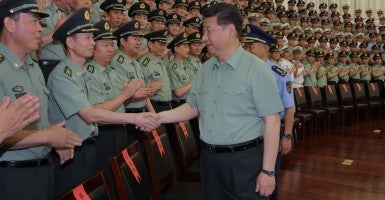What is China up to? It’s been building artificial islands in the South China Sea. Recently, two motorized artillery pieces were spotted on one of these artificial islands. Experts believe the Chinese may plan to use them as airstrips.
On May 20 the Chinese navy challenged a U.S. surveillance aircraft flying near one of the islands. It demanded that the U.S. plane leave its “military alert zone,” even though it was flying in international airspace.
Stung by Beijing’s aggressiveness, Defense Secretary Ashton Carter pushed back. “We’ve been flying over the South China Sea for years and years and years,” he told reporters last week, “and we’ll continue to do that—fly, navigate, operate.”
Beijing has been pressing territorial claims in the East China and South China Seas for years. Experts believe Beijing is bent on territorial expansion so that it can play an even greater role in world affairs.
But Chinese officials dismiss such talk. They describe their actions as defensive, making themselves out as victims of hegemonic powers and interested only in protecting their sovereignty.
An official Chinese white paper on military strategy released last week should put the matter to rest. It shows quite clearly that China is developing a grand plan not only to use military power to defend its expansive territorial claims and influence in East Asia but also to challenge the U.S. as a rising global power. It puts their provocative actions of building islands and flagging down U.S. military aircraft in their proper perspective.
The first thing to note is that the military strategy is described as “active defense.” This is a technical term that really means China envisions the need for offensive military operations. It’s a far more aggressive stance than we are used to, at least in terms of public statements made by the Chinese government about the purposes of their military strategy.
The new offensive component of its war plans actually has its own acronym, PMS, for “preparation for military struggle.” China’s military forces will prepare to win “informationalized local wars, highlighting maritime military struggle and maritime PMS.”
Cutting through the jargon, it means that the purpose of force is not to deter wars but to win them. It also shows a heavy emphasis on cyber warfare and a new focus on moving away from land power toward the offensive intent—admittedly quite openly. China’s air force will “shift” from territorial air defense to “both defense and offense and build an air-space defense force structure.”
Note the word “offense.” Thus we can expect more challenges of U.S. military aircraft over the international waters that Beijing unilaterally declares as part of their defense perimeter.
Then there’s the Chinese navy’s addition of “open seas operations” to its existing focus on “offshore waters defense.” When combined with the army’s new focus on “trans-theater mobility,” and not merely on the more modest “theater defense,” you start to get the picture.
China thinks it needs those man-made islands and robust new land and naval capabilities not only to operate in the “open seas” but to move military forces from one theater to another.
The Chinese government is putting its money where its mouth is. It announced a 10 percent increase of the military budget for 2015. That would make China the second-largest military spender in the world. Increases in defense spending have been outpacing GDP growth rates for years, and although China’s defense spending is still far below America’s, it is growing while the U.S. is cutting its defense expenditures.
All of this adds up to a bold new role for China’s armed forces. Long thought to be content with the mere defense of its mainland territory, China is clearly staking a larger claim for itself. It is striving to become the dominant military power in East Asia for sure, but also, in the long run, a rival challenger to American military power.
Originally published in The Washington Times




























